Colours
Home: white shirt with black trim and Schwarz-Rot-Gold diagonal pinstripes, black shorts, white socks
Away: green shirt with white trim, white shorts, green socks
Overview
Coach: Joachim Löw.
The two Trikots released in time for the 2012 European Championship finals in Poland and the Ukraine were undoubtedly new, but with a touch of the familiar about them. In a move away from space-age back towards a more classical look and feel, the creative artists at Adidas plumped for two styles based almost directly on classic shirts from the past, but with a number of uniquely modern touches.
The 2011-2013 white home shirt would take its cues from the simple v-necked design sported in the mid-1980s, though with the addition of three black, red and gold diagonal pinstripes running down from the top right shoulder which are a completely new feature. Both the Adidas logo and the eagle crest – adorned by the three championship stars – are all in black, as are the three immediately recognisable stripes that run down the shoulders.
As with all modern shirt designs, there are a number of unique design features on the 2011-2013 Trikot, not least of which is the ultra-modern plastic material used for the eagle crest and three championship stars. This material was used for the metallic gold crest on the previous shirt designs, and provides a contemporary element to what is essentially a classic design with the overlapping v-neck last seen on the short worn during the 1984 European Championship campaign. The three diagonal pinstripes provide a bit of colour to the traditional Schwarz und Weiß, and follow on from the three vertical bands sported on the previous design.
Thomas Müller in the 2011-13 Heimtrikot, against Portugal at Euro 2012 in Lviv
While the previous design had the Adidas logo in the centre to accommodate the player’s squad number on the right side of the chest, this new design reverts to a more standard layout that sees the crest to the wearer’s left, the Adidas logo to the right and space for the squad number in the centre. At the base of the front of the shirt is a new security hologram in the shape of a parallelogram and the “Climacool” logo printed in black and silver.
The reverse of the home shirt is fairly simple, with just a small design feature just below the neckline with the legend “Deutscher Fussball-Bund” embossed in black cursive script and a small flag tab device machine-woven in fine black, red and gold thread.
The 2011-2013 Heimrikot could very easily have been associated with a fourth European Championship triumph, but in the end I will always associate it with that traumatic evening in Warsaw, and the semi-final defeat at the hands of old rivals Italy. In fact, whenever I think of that shirt the first name I can think of is Mario Balotelli.
The Auswärtstrikot for 2011-2013 saw the return of the popular green and white colour combination after some ten years, and a design clearly modelled on the famous Lindengrün shirt sported by the European Championship winning side of 1972 – with a subtle touch of the mid-1980s. Needless to say, this simple and well thought-out retro design was an instant hit for many fans of the Nationalmannschaft, including myself.
While the recent black design had been a stylish success there had always been something special about the green away shirt – and even better still was the return to the classic Lindengrün, as opposed to the forest and racing green variations of the 1990s. The tradition is made clear by the legend on the inside of the neck: 1972 – der Beginn einer Erfolgsgeschichte, 2012 – ein neues Kapitel wartet darauf, geschrieben zu werden!. “1972 – the beginning of a success story, 2012 – a new chapter waiting to be written!”
Just like the 1972 version on which it is modelled, the new away shirt is beautiful because of its simplicity: core green, with a white round neck and trim. The three stripes in white adorn the shoulders, while the meshed body of the shirt itself makes a subtle nod to the two-tone horizontal stripe effect that featured on the Trikot worn between 1984 and 1986.
Both the Adidas logo and the eagle crest are machine-woven onto the shirt, with the Adidas logo in white/silver thread and the national crest in black thread on a white/silver base. Above the national emblem are the three championship stars, all woven in a subtle green thread; the only reason I can see for this is that from a distance they cannot be seen, thus making the shirt look more like the 1972 version. As with the home shirt, the Adidas logo is positioned to the wearer’s right and the national emblem to the left, making room for the player’s squad number in the centre.
As with the white home shirt, the base of the front carries the new silver parallelogram security hologram and the “Climacool” logo printed in white and silver.
Dressed in green, Per Mertesacker congratulates ‘keeper Roman Weidenfeller at Wembley in 2013
The reverse of the shirt is plain and simple, with the exception of a very subtle embossed “Deutscher Fussball-Bund” legend in green just below the neckline. As with the three green stars on the front, this feature can clearly be seen when inspecting the short up close but blends into the rest of the background when viewed from a distance.
While the original green design will always be associated with the glorious 3-1 triumph over England at Wembley in 1972, the more recent incarnation was, if anything, something of an unlucky omen. Only four games were played in the shirt, and three of these were defeats. That one victory – a 3-0 win in the Faroe islands – was not particularly memorable, and the one game that will always come to mind when I think of this Trikot will be the ridiculous 5-3 friendly defeat in Switzerland just before Euro 2012.
Interestingly, the player that comes to mind when I think of this green shirt was not even wearing it during the match. Goalkeeper Marc-André ter Stegen, making his international debut, would endure a terrible ninety minutes between the sticks in Bern. Just over a year later the same player – with his team mates again in the Lindengrün – would score an horrific own goal in a 4-3 defeat against the United States in Washington DC.
Tournament Record
2012 UEFA European Championship, Poland/Ukraine: semi-finalists
Shirt Debuts
White: v Ukraine, 11.11.2011, Kyiv.
Team: Zieler – Boateng, Badstuber, Hummels – Träsch (46. Schürrle), Kroos (87. L. Bender), Khedira (46. Rolfes), Aogo – Götze (66. Müller) – Özil (66. Podolski) – Gómez (83. Cacau)
Score 3-3 (Kroos 39., Rolfes 65., Müller 78. / Yarmolenko 28., Konoplyanka 36., Nazarenko 45.)
Green: v France, 29.02.2011, Bremen.
Team: Wiese – Boateng, Hummels, Badstuber (46. Höwedes), Aogo – Khedira (70. L. Bender), Kroos – Reus (70. Cacau), Özil, Schürrle (45. Müller) – Klose (46. Gómez)
Score 1-2 (Cacau 90.+1. / Giroud 21., Malouda 69.)
Shirt Images
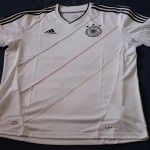
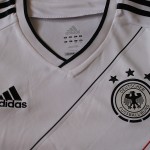
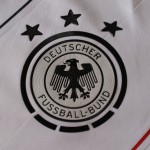
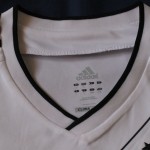
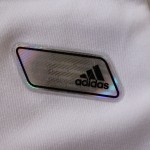
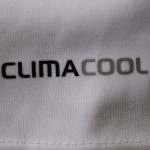
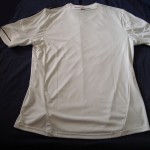
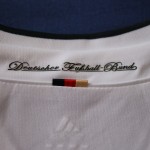
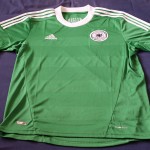
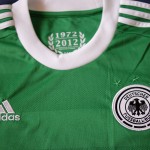
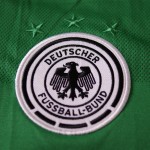
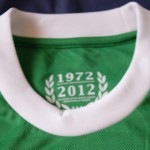
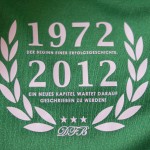
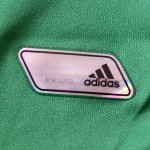
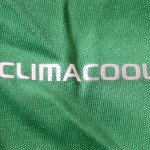
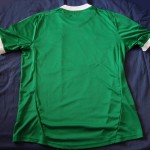
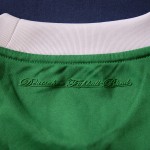

This is the pair where the away trikot managed to finally beat the classic feel of the home one. I remember seeing this the first time in an airport, and was amazed that they had finally reissued this green design as an official Mannschaft garment. I really loved this simple, ‘so-seventies’ design so associated in my mind with the epic photographs of that 1974 deluge game against Sweden. Beautifully crafted too! No wonder it has been one of the most expensive trikots of the decade! :O
Pingback:Schwarz und Weiß | Blog | The Fine and the Fake